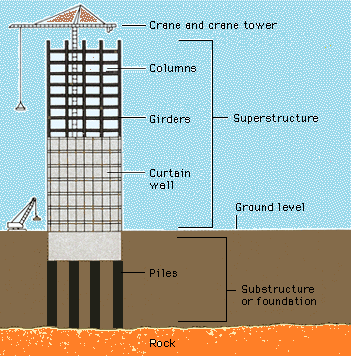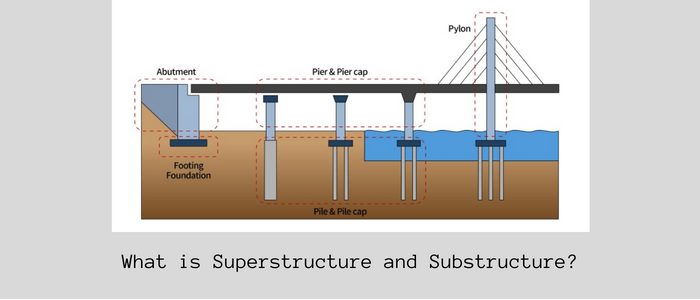In construction of any type of building or structure, there are two parts that exist in the project; namely, they are the superstructure and substructure. So, let us have some discussion on the meaning of both terms and what they are referring to.
Definition of Superstructure and Substructure
The “superstructure” refers to all the components that are built above the level of ground, whereas everything built underground (below the level of ground) is termed as “substructure”.
It might seem at the beginning that superstructure is more important than the substructure since it has the bigger size and height but in fact both parts also almost equally crucial for the safety and stability of any type of structure.
Now, let us see some key differences between the super- and sub- structure.

What is Superstructure?
A building’s superstructure is where people will spend the majority of their time. The first and second storeys of a house as well as any number of floors in bigger structures fall under this category. Beams, columns, finishes, windows, doors, the roof, floors, and everything else are considered to be part of the superstructure.
The term “superstructure” denotes the whole part of a structure that is above ground or the foundation.
Components of the Superstructure
Floors and roofs
The different levels of a building are divided by the floors of the superstructure. Of course, you can walk around it, set furniture on it, and store a lot of things there as well.
The building’s interior is shielded by the roof from weather conditions including wind and rain. Numerous roofing solutions are available. However, flat roofs function well in the lowlands whereas slanted roofs are advised in highland settings.
Beams and columns
The horizontal components that can support all vertical loads that come from the floors and roofs are beams. The ends of the beams transfer all of the weight from those vertical loads to the columns or beam supports.
Vertical supports for the loads are columns. When more weight is placed on top of any improperly installed columns, they will fall. Naturally, all of the pressure transfers from the columns to the foundation.
Reinforced Concrete Walls
R.C walls are vertical elements that transfer a portion of the vertical load. They also transfer the horizontal loads that come from the wind and earthquakes.
Parapets
Parapets are the outside walls that protrude past the roof slab. This section of the superstructure serves as a safe haven for persons on the roof while preventing water from rushing over into the building’s entryway.
Doors and windows
The superstructure of a home or building also includes all of its doors, windows, and other openings. The size of the structure or residence will determine how many windows, doors, and other openings there are.
Lintels
The region above any doors and windows is called the lintel, and it serves to support the wall above the bigger openings. In addition to reinforced concrete, concrete and bricks may also be used to create lintel beams.
Walls
We would all live in homes or buildings with large, open areas without walls. However, walls are constantly put up to enclose particular portions of structures since none of us wants our bedroom next to the kitchen. The majority of walls are constructed of masonry or concrete, and they support the weight of the roof, slabs, and even the beams.
Stairs, ramps, and elevators
The superstructure is made up of all those vertical transportation systems that you find in homes and buildings. In contrast to residences, where ramps and stairs are frequently the only accessible features, buildings typically incorporate elevators.
Finishing materials
Most people overlook the fact that all of the interior details of a house or building are a part of the superstructure. This covers the heating and cooling equipment as well as the trim, flooring supplies, curtains, and blinds.
What is Substructure?
The part of the structure that is buried underground is referred to as the substructure. The building’s weight is dispersed throughout the substructure and the ground underneath it. Thus, the superstructure is constructed level with the ground. A structure’s substructure may make or break it. Working with structural engineers is essential to preventing the collapse of the substructure’s piers, support beams, and foundations.
A building’s foundation serves to transmit loads from the superstructure to the ground underneath. The substructure is directly up against the earth that supports it because of this.
The substructure is typically constructed of plain cement concrete or reinforced cement concrete. Once it is established, more concrete, bricks, or stones are placed until the entire structure reaches the plinth level. To ensure that no section of the substructure is affected by moisture, a damp-proof course must be installed on top.
Superstructure vs. Substructure
| Superstructure | Substructure |
| The area of a structure that is constructed above the ground | The portion of a structure that is underground |
| Include columns, windows, doors, beams, floors, and walls | It is made up of the piers, abutments, and foundation such as footings and piles |
| Transfers weights from the building’s upper portion to its foundation | Enables the superstructure to transfer weights to the building’s foundational soil |
| It encompasses the area of the structure that is below the plinth. | It extends over the portion of the building that is between the top of the plinth and the building’s top. |
| Provide a place to live and shields the building from the elements | It sustains the building and keeps it from falling down. |
Read Also:
